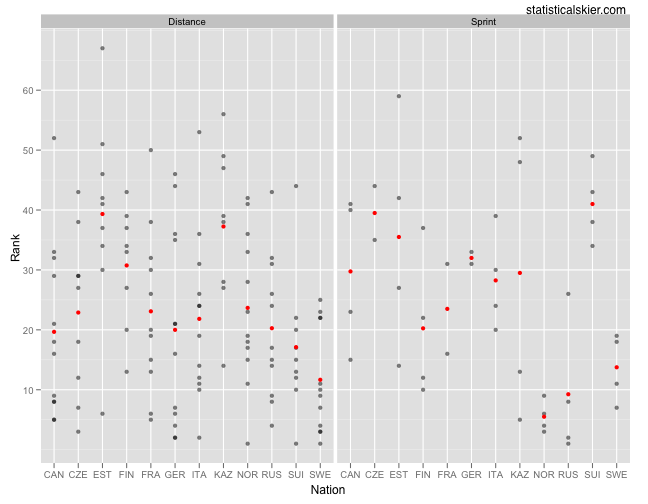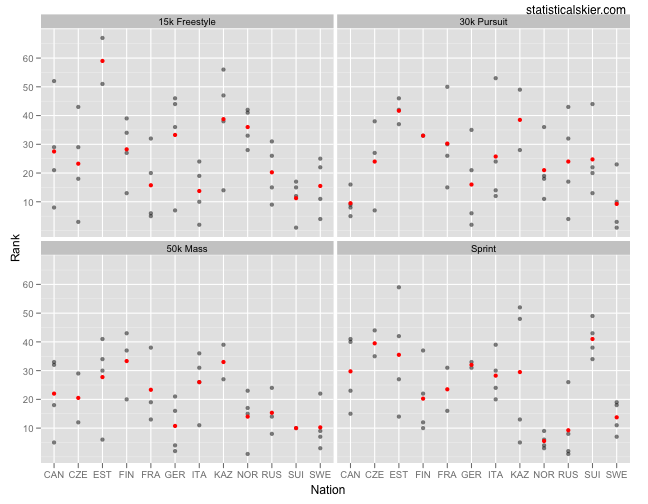Adam, over at NordicXplained, asks:
“Everyone knows how well the Canadian men’s team did at the Olympics, but the question that I wanna know is how well they stacked up against other countries. Even though they didn’t win a medal, their average placing in many races surely could have been higher than traditional powerhouses like Russia and even Norway in the opening 15km classic.”
Can do!
A few cautionary comments before we get going. Â At the Olympics, each nation can only start four people in any given race. Â So comparing team performances using only summary statistics may be dangerous here. Â We’d be averaging four values! Â It’s easy to get sucked into trying to invent some arcane numerical summary to “fix” this problem, but usually it’s just best to plot the data and look at it. Â The answer is often fairly clear without having to do any fancy math.
Adam’s question deals with team performance, so that’s what I’ll look at. Â That means that as I evaluate the data, I’m going to consider every result, top to bottom, for each nation. Â What counts here is the performance of the “group”. Â Socialism! Â Yay!
Let’s start by looking just at what place people came in, for the traditionalists out there:
Each (non-red) dot represents a result by an individual skier. Â Darker dots mean that there are two dots being plotted over each other. Â The red dots are the mean for each nation. Â There were three individual distance races and one sprint race. Â We can dispense with the sprint race right off the bat. Â The Canadian men aren’t (to my knowledge) known to excel in sprinting, and this bears that out. Â Norway and Russia pretty much owned that event.
On the distance side of things, there is a clear winner, and it is Sweden. Â Their average result was fully 5-6 places better than the next country (Switzerland) and their worst result was only 25th or so. Â Picking a second place country gets a bit muddier. Â Switzerland would be the obvious choice, except that Germany had more top ten results (7 vs. 2). Â On the other hand, Germany had more results worse than 25th (4 vs. 1). Â And of course, we have the reason for this post, the Canadians, nipping at both their heels.
Using my arbitrary discretion wand, I’d call it this way:
- Sweden
- Germany
- Switzerland
- Tie: Canada and Russia
- Tie: Norway, Italy, France and Czech
Recall that I’m not really giving much in the way of special bonus points for having one skier who lands on the podium. Â I’m trying to judge the performance of every skier on each team. Â And obviously there’s a lot of judgement at play. Â For instance, I gave Germany a little extra credit for the number and quality of their top 10 results (7 of them, and better on average than Canada’s 7 top ten results). Feel free to debate amongst yourselves in the comments.
Let’s break this down by each individual race:
Not surprisingly, we see that Canada had a spectacular race in the 30k Pursuit (as a team, anyway). Â I should also point out that Canada’s one bad result in the 15k was Gordon Jewett’s only individual race of the Olympics. Â I hate to pick on specific skiers, but there’s the possibility that if Devon Kershaw had started in place of Jewett in the 15k, the Canadian men might not have had a single distance result over 35th. Â This isn’t a knock on Jewett. Â Rather, we should interpret it as an indicator of just how impressively Kershaw, Harvey, Grey and Babikov skied at the Olympics this year. Â Those four guys were just feeling it.
I should mention that Norway, a typical powerhouse, had a truly abysmal Olympics in the distance events. Â Petter Northug won the 50k, obviously, but other than that they didn’t have a ton of success. Â Certainly not to the extent they are used to. Â So outclassing the Norwegians as a team this year should come with something of an asterisk. Â Still, credit is due to those who show up and race fast.
Finally, I’ll provide the equivalent graphs using FIS points, which tell roughly the same story. Â I’ve gone the “fancy” route here and adjusted the FIS points. Â Basically, that means that the 30k and 50k points have been scaled to be more comparable to interval start points. Â You can read up on how this works in more detail here.




{ 2 } Comments